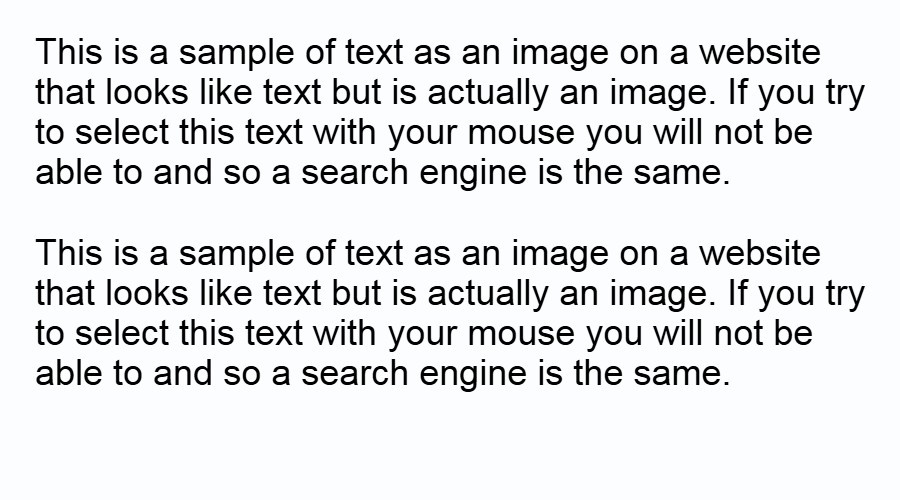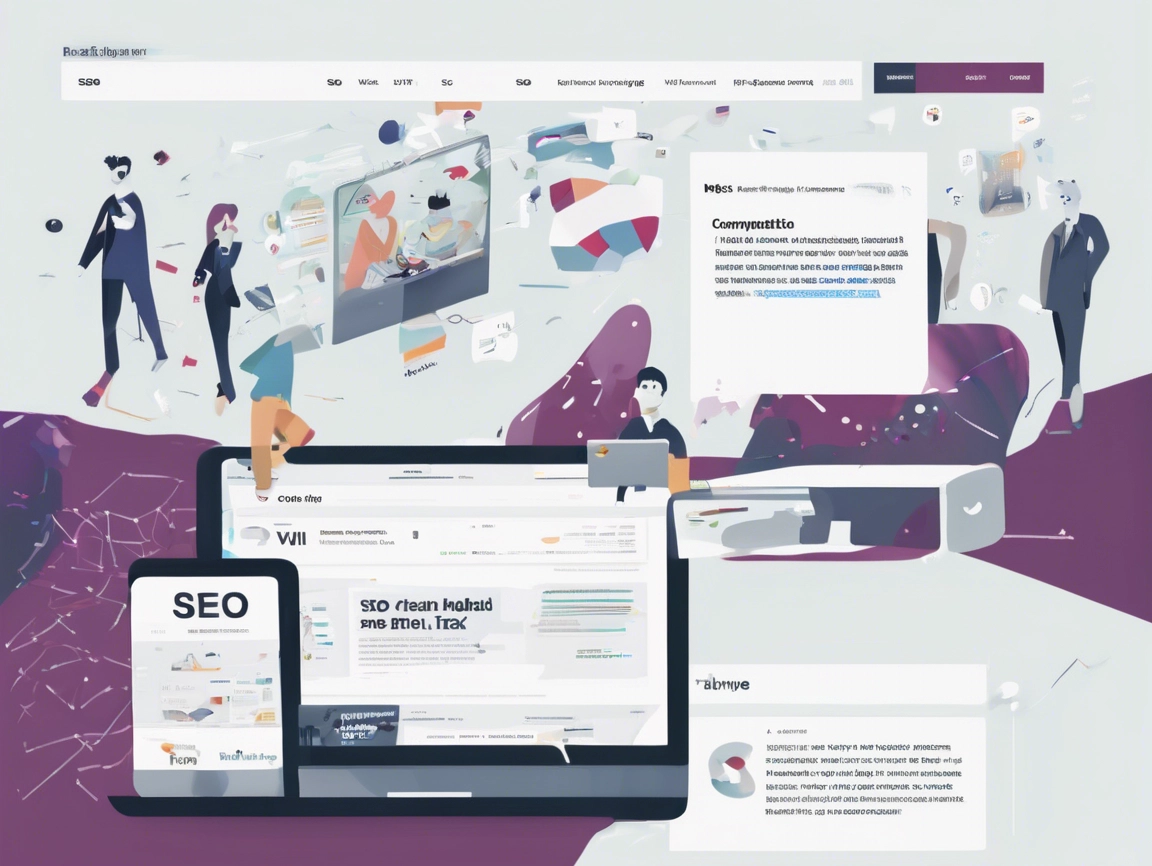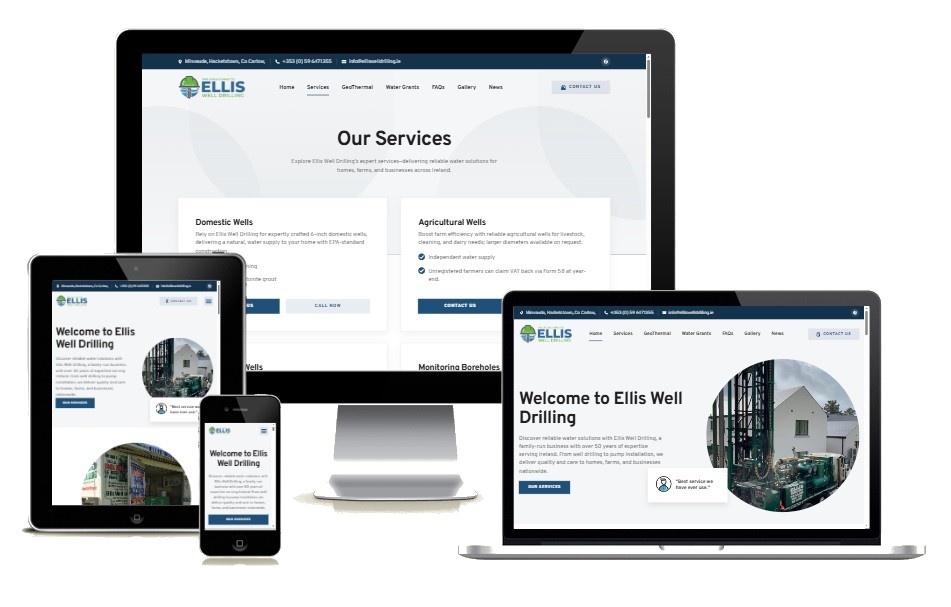This week we had an inquiry to help a business with their websites SEO. They had a new admin in the company who knew how to use WordPress and so handed over the keys to edit on the website. Over the past year the website has dropped off search engines and they are now spending more on Google Ads to get back to their original position in search results. The owner of the business assumed the person looking after the site was doing a good job as its looked OK and was updated regularly too. So why was it nose diving in Google?
Well, when it comes to website design and SEO we have an expression in that the “Content is King“, but only of the content is actual real content that a search engine is capable of reading. Using “Text as a Graphic” may seem like a creative solution, but it’s actually one of the most common mistakes that can tank your SEO efforts. Its as true today as it was when i was first blogging about this over 20 years ago !!!
Don’t misunderstand me, graphics are very important to the design, but not as actual text that you wish to be indexed by search engines in order to come back in a search result. It turned out that their website was 95% made of paragraphs of text as images !! The Homepage was basically Blank from the Search Engines point of view !
Yes, pictures of actual text. I think it’s like giving a blind person a photo of braille and asking them to read it, well its the same thing as asking a search engine to read from an “image of text” !! See sample below.

Using “Text as a Graphic” Hurts Your SEO
When you embed text directly into an image or graphic, you’re basically telling search engines, “Hey, don’t bother reading this.” Unlike humans, search engines can’t “read” text inside an image unless it’s accompanied by metadata or alt text. This practice might look aesthetically pleasing, but it creates a myriad of problems:
1. Search Engines Can’t Index Graphic Text
Search engines rely on HTML text to understand a webpage’s content. When your important headings, keywords, or calls-to-action are buried inside an image, they’re invisible to Google, Bing, and other search engines. This means your site won’t rank for those keywords, no matter how beautifully designed your graphics are.
2. Terrible for Accessibility
Not everyone consumes content the same way. Screen readers used by visually impaired individuals can’t interpret text within images unless you’ve added alt text (and let’s be honest, most people forget to add it). This exclusionary practice not only harms your user experience but can also get your site flagged for non-compliance with accessibility standards.
3. Slows Down Page Load Speed
Images naturally take longer to load than plain HTML text. If your site relies heavily on graphics with embedded text, you’re increasing load times. And guess what? Slow-loading websites get penalized in search rankings.
4. Not Mobile-Friendly
With the majority of web traffic coming from mobile devices, scalability is critical. Text inside graphics often doesn’t resize properly on smaller screens, leading to a poor user experience. Search engines prioritize mobile-friendly sites, so this could hurt your rankings even more.
5. Missed Keyword Opportunities
SEO is all about strategically placing keywords throughout your site. But when those keywords are inside an image, they’re essentially useless to search engines. You’re missing out on the chance to rank for relevant searches and drive organic traffic.
The Difference Between Graphic Design and Website Design
Here’s where things often get confused: graphic design and website design are not the same thing. Sure, they overlap in certain areas, but their goals are fundamentally different.
Graphic Design
- Primarily focuses on visuals and aesthetics.
- Includes creating logos, brochures, social media graphics, and other visual materials.
- Text in graphics is perfectly fine for print or social media, where SEO isn’t a factor.
Website Design
- Balances aesthetics and functionality.
- Prioritizes user experience and SEO optimization.
- Ensures that all text, headings, and keywords are crawlable by search engines.
When building a website, it’s crucial to think beyond how it looks. Functionality, speed, accessibility, and SEO must all work together seamlessly.
Alternatives to “Text as a Graphic”
You don’t have to sacrifice design for the sake of SEO. Here are some smart alternatives:
1. Use Web Fonts
Modern web design tools offer a plethora of font options that can mimic the look of graphic text without the SEO drawbacks. Tools like Google Fonts make it easy to integrate stylish, readable text into your site.
2. CSS Styling
Take advantage of CSS to create visually appealing text effects. You can add drop shadows, gradients, or other design elements directly to HTML text without sacrificing SEO.
3. SVG Text
If you absolutely must use custom-designed text, consider using Scalable Vector Graphics (SVG). Unlike regular images, SVG files allow search engines to index the text inside them.
4. Fallback Options for Images
If you’re using text in an image, always include alternative text (alt text) and captions. While it won’t fully replace HTML text, it’s better than leaving search engines completely in the dark.
5. Test Your Website
Use tools like Google’s PageSpeed Insights or Lighthouse to see how well your site performs in terms of SEO and accessibility. Regular testing ensures you’re not accidentally harming your rankings.
FAQs
1. Can I use text in graphics for social media?
Absolutely! Social media platforms aren’t reliant on SEO in the same way websites are, so feel free to use text in graphics for posts or ads.
2. How do I know if my website is using “Text as a Graphic”?
Inspect your website’s source code. If you can’t find the text you see on the page in the HTML, it’s likely embedded in an image. Try selecting the text on a website, if you can’t then search engines can’t either and thats a quick way to find out.
3. Can alt text fix the issue?
Alt text helps, but it’s not a complete solution. Search engines still prefer HTML text for indexing and ranking.
4. Does embedding text in graphics affect paid ads?
Not directly, but poor SEO can lower your Quality Score on platforms like Google Ads, potentially increasing your ad costs.
As I said at the beginning I’ve been moaning blogging about SEO best practices for over 20 years, and yet, we still see businesses falling for this classic mistake. It’s not that we’re complaining—it gives us plenty of work fixing these issues—but it’s a costly oversight for business owners who simply didn’t know the difference between graphic design and website design.
So, the next time you’re tempted to use “Text as a Graphic,” remember: what looks good to the human eye might be invisible to search engines. By focusing on SEO-friendly design practices, you’ll not only create a beautiful website but also one that performs well in search rankings.
Call Dave on 053 9430748 to talk about SEO and Website Design done right.



